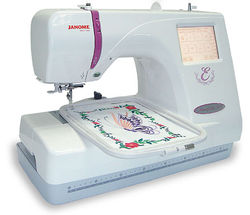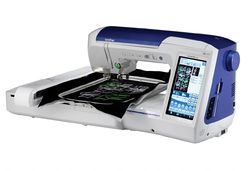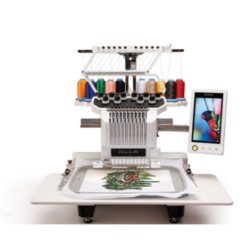Embroidery machine
Introduction
Nearly all of today's embroidery machines are computer controlled machines that will stitch a digitally created embroidery design.
The first computerized embroidery machines for consumers were introduced in the 1980's. As of 2018, a large choice of models and brands exist and prices have been dropping over the past years. E.g. a decent entry-level machine now costs about 600 Euros.
Computer-controlled embroidery machines have a “specially engineered machines that have a multi-needle fixed ‘embroidery head’ and a frame holder that moves the framed product (for example a garment like a Tshirt) in either of two directions so that the embroidery design can be sewn. The frame holder is known as a pantograph; think of it as a graph plotter because it moves to (plots) the exact location (co-ordinates) of the design expressed in x and y values. The design is created within a grid (known as a ‘field’) with x being the horizontal axis and y the vertical axis. Therefore any point on the design can be identified in values of x and y, a co-ordinate in this field would be written, for example, as x249,y786. The embroidery machine reads these co-ordinates from the design data file and moves its pantograph into position to receive each new stitch from the machines’ stationary needle head.” (An introduction to Computerized Embroidery, retr. June 2018)
Machine embroidery is part of some "making" cultures. For example, an embroidery machine is in the standard list list of fab lab equipment. This shows that
See also:
- Computerized embroidery (Introduction)
- Brother PR1050X
- Elna 8300
Criteria for selecting an embroidery machine
- Overall mechanical quality, in particular reliability and precision.
- Hoop-size (frames for the embroidery area) is critical. 14x20 cm is expected for mid-level machine and many folks consider this as a must-have minimum. So-called Jumbo hoops (e.g. 40x26cm) exist on high end sewing/embroidery machines and multi-needle models. There also exist a third-party market for hoops. However, on some machines, jumbo hoops are difficult to use since designs must be split so that the hoop can be turned around. Finally, one also needs a tiny hoop (free arm hoop) for embroidering on tight places
- Stitches / minute (SPM). Should be at least 500. Typical range is between 400 and 1000, e.g. a Elna 8300 can do 750/minute a high-end consumer model like the Brother PRX1000 can do 1000/minute.
- Built-in fonts, patterns and designs may make a difference to people who prefer designing on the machine (as opposed to using a software on PC).
- Needle threader (helps putting the thread into the needle or does it without assistance)
- Thread cutter
- Support for standard USB flash drives (keys) and direct PC link
- User interface quality and functionalities. It should allow for simple editing like translation, rotation, resizing, time/stitch counting, design tracing of a design.
- Free (or cheap) software
- Slide speed control
- Automatic detection of fabric and thread tension regulation
- Sensors that will tell you if something went wrong, in particular broken threads.
- Local dealer support
- Pricing
Kinds of machines
As of April 2011 (slightly revised in 2017). Information below can change rapidly and we may not update !
With respect to sewing and embroidery functionality we could distinguish four kinds of machines:
- Single needle embroidery machines (between 800 and 4000 Euros)
- Sewing machines with an embroidery module or combined sewing/embroidery machines
- Multi-needle semi-professional embroidery machines (between 4 and 10 needles)
- Multi-needle professional embroidery machines (between 9 and 16 needles)
Entry and mid-level pure embroidery machines
Mid-level machines work fine, but you have to change threads a lot and finishing (e.g. removing jump stitches) requires more work. Also, precision will not be the same. Entry-level machines usually have smaller stitching areas, smaller and simpler interfaces, and probably not as good mechanics.
A typical example (as of spring 2011) of a lower mid-level embroidery-only machine is the Brother Innov-is NV 750E. It costs about CHF 1500 or € 1100 (only about $800 in the US) and has a 18x13cm embroidery area (hoop). At the time of writing this model may probably offer the best feature for money ratio.
Another popular example is the Elna 8300 and it comes with a standard 12.6x11cm hoop and a larger hoop of 20x14 cm. The Janome MC 350 E is almost identical. Both cost between € 1400 and 1600, i.e. about US $2000. We paid our Elna, CHF 2300 in a Geneva shop and we didn't get any educational rebate. With respect to most other machines it has the advantage of a relatively small arm, i.e. one can embroider leaves.
There are also cheaper models, however you may not find these in some countries. Low-end machines are often not sold in sewing shops, but in supermarkets and other mass let-outs. Good models seem to be the Brother Innov-is 90E (about € 600), the Brother PE-770 (at $670 on sale) or the Janome MC200E ($900). Even cheaper would be a Brother SE400 sewing/embroidery machine ($400). If you are low on budget, look out for special deals for end of series models.
Most higher mid-level embroidery machines are also sewing machine (see next item). It seems that they don't offer better precision, but are more expensive because of the sewing functionality.
Lower and higher Mid-level sewing/embroidery machines
The choice for mid-level combi machines is enormous. There are differences in features and large differences in prices. I wonder, whether the difference in price doesn't reflect better mechanics but rather the better built-in LCD panel and software. Someone like me would not necessarily need that kind of on-board control, since we feel comfortable doing everything with a computer.
For example, a Brother sewing/embroidery Innov-is 1500 with a 26x16cm hoop and a large LCD costs about 2.499,00 €. The Bernina Aurora 450 sewing machine plus embroidery module costs about CHF 3500. The (oval) hoop size is 25.5x14.5cm and the model has a smaller LCD, but probably better mechanics. A Husqvarna Topaz 20 includes a large hoop of 36x20cm and costs about € 1800 and the Topaz 30 is about € 2200.
A higher mid-level machine would have a larger color screen, more stitches, more built-in software (both functionalities and designs). E.g. a Brother Innov-is 4000 or a Bernina Artista 640 with embroidery module would cost about CHF 6000.
High end sewing / embroidery machines
A high end-end sewing/embroidery machine like the Bernina 830 or the Brother Quattro (same as Innovis I in Europe?) are in the CHF 8-10000 price range, e.g. similar as entry-level multi-needle embroidery machines. Some brand's high-end machines are a bit cheaper. e.g. the Elna 9600 "Haute Couture" and the practically identical Janome 11000 are about € 5000. According to one sales person we interviewed, high end machines are not necessarily better in terms of precision than mid-end machines. They just add extra functionality.
These machines feature a very large screen and advanced on-screen editing. Mechanics might be better, but we don't know. The problem that one has to change threads remains. These are probably dream machines for combined sewing/embroidery, but not necessarily for just embroidery. Read on if you plan to get a dream machine.
multi-needle embroidery machines
A true entry-level embroidery machine (i.e. a device that has four to six needles) costs around 9-12 K CHF. Street prices seem differ in different countries. E.g. (in 2012) the Brother PR-650 did cost Euros 7700 on amazon.de / CHF 11'000 in a Swiss shop / $7500 in the US. A Babylock professional Plus is about $ 10000 in the USA. A Korean SWF/MA-6 is also about $11000.
- An 4-needle Elna 9900 is about € 6500.- and the almost identical 4-needle Janome MB-4 about € 5500 to 6000 or US$ 7000.
- A ten needle Brother PR1050X costs about $ 9500.- in the USA, much more in Europe. In that price range, that probably remains the high-end prosumer machine to buy as of June 2017. In Switzerland list price is 12'000CH, some sell it for less, i.e 10'000. For education, prices still can be lower.
- The Babylock Valiant BMV10 looks similar to the Brother PR-100x models.
- A Tajima SAI 8-needle machine cost around € 8500.- + value added tax, in Europe. Tajima is the leading industrial machine manufacturer.
- Fuwei models cost much less, e.g. a 15 needle Machine that looks like a Brother PR is only 7500 Euros (in France)
- Industrial multi-needle embroidery machines
You then could look at simple industrial machines. These are faster, may have more needles and are of course more expensive. An entry level Tajima Neo II is about 14000$ in the US. Prices for that type of machine seem to differ a lot from shop to shop and from country to country.
https://fuwei-france.fr/ Fuwei] models, made in China cost much less, e.g. a 15 needle industrial machine is about 8000 Euros.
Other machines like the Melco EMT16 can do 1500 Stitches/minute and stitch on most materials. It has less builtin editing i.e. design is entirely done with a computer. Maybe the simpler design makes these a bit more robust than the Brother PR 1050X who has more electronic bells and whistles, but I really do not know. This model has other advantages, e.g. the smallest arm, being able to print on 270 degrees, (optionally) more than one print head, etc. It also can be used in an industrial setting, e.g. several machines can run jobs from one PC. The 16 needle Bernina E-16 (is made by MELCO) and may cost the same as the equivalent MELCO Amaya EMT16 at around 17000 Euros.
Listing of embroidery consumer brands
I have no idea which types/brands are best, except that it is always better to buy from a shop nearby that also can repair a device. E.g. in Geneva I would not buy a Brother, since there is no authorized dealer. Please visit sewing / embroidery forums if you need advice from people who got experience. The following list includes most major brands (I believe) and some additional pointers. This section was probably last updated in 2012!
- Baby Lock
- owned by Tacony
- babylock.com (official website)
- Bernina
- independant Swiss company Bernina, swiss made
- Also owns the lower-end and cheaper not swiss-made Bernette brand
- Bernina Sewing Machine (Wikipedia)
- Bernina.com (official website)
- mybernette.com (official website of the Bernette line)
- Brother
- Japanese company
- has two lines, consumer and industrial
- brother.com (official global website) - brother USA - Brothersewing CH ...
- Bother also develops for Baby Lock
- Elna
- Swiss company (owned by Janome or strong partnership ?)
- Official website
- Husqvarna Viking
- owned by SVP Worldwide
- Husqvarnaviking.com (official website)
- Janome
- Japanese company, also seems to create models for various other brands
- Janome (Wikipedia)
- Janome.com (official website)
- Kenmore
- owned by Janome
- Singer
- owned by SVP Worldwide
- Singer Corporation (Wikipedia)
- singer.com (Official website)
- Toyota
- home-sewing.com (official website)
Some brands are owned by the same company. For example SVP owns Singer, Husqvarna and PFAFF and is the world's largest sewing machine company. Sometimes companies share development (for either the mechanical or electronic parts or both) or have an entire model made by another company. Difficult to know who exactly produces what...
Open source embroidery machines
Opensource embroidery machines do (as of 2015) not exist. There are no buildable functional examples of homebrew embroidery machines.
However, some people have built hardware, that you could reproduce. For example, look at this embroidery machine with XY belt and pinion drive built by someone in 2014.
Or this lego NXT controlled sewing machine with XY movement, [1] built in 2014.
There is this build from 2018 from 3d printable parts [2].
While there is very little that prevents such machines from being built, there simply hasn't been any real workable examples on par with some of the open source 3d printers or open source cnc machines. Both of which share considerable technical overlap with machine embroidery. However successful methods seem to take an existing sewing machine, mount cloth in a hoop hooked to an XY plotter, and then add something to turn the handwheel. Performing a stitch in two discrete steps. In the 2018 example this is seen by the gcode it uses:
G0 X0.0 Y0.0
G0 X15.231 Y-18.482
G0 Z5.0
G0 X15.310 Y-18.482
G0 Z10.0
G0 X15.390 Y-18.482
G0 Z15.0
G0 X15.310 Y-18.482
G0 Z20.0
In this case the G0 controls the X,Y plotter to new location. And the change in Z is used to change the wheel location. So each stitch is treated as two commands. One to move the plotter then one to turn the wheel. There is very little to prevent additional G-commands from being utilized by a control board declaring some G-code value to perform a trim and supplying hardware to perform such an action. A considerable amount of modern embroidery uses things like jump stitches to block the needle bar specifically because each cycle much stitch and has limits to the distance traveled because there's only so far the stepper motor can move before the next stitch cycle. While slower, these modified sewing machine methods are quite effective. And could lead to more general and standardized approaches going forward.
Links
- Google
choosing "embroidery machine. We did not find any exhaustive guide that was based on real testing.



